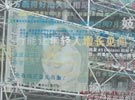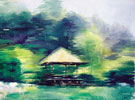Silence is Space
The Photography of Christopher Taylor
I love Christopher Taylor's photographs and, if someone I enthusiastically show them to happens to ask why, I feel a contrariety that cannot be smoothed out through discussions or explanations. I just end up shrugging, feeling disappointed. I am not seized by a didactic afflatus and have no intention of illustrating my point; rather, I cannot do so. One either has, or does not have, a certain sensibility; it can't be learned or taught.
I also love the writings of Robert Adams, and am almost certain that Christopher also admires them. Both share a love of nature and take the time to track and observe its splendors, given that “those willows edging the river were splendid in the spring […] and could be more splendid still in September.”
Yet time is not a “seasonal” entity in Christopher's photographs, not to mention a “fleeting” one: he does not immortalize a given moment through a snap of his camera, but captures and bears witness to the less mortal, more durable nature of “reality.” The feeling I was struck with and enchanted by, right from the outset, was a sense of timelessness. These are places and viewpoints that are not subject to changing moods, or the chaotic din of passersby, or even the transient synergies arising from a chance encounter, but instead constitute the distilled essence of an artistic vision that is enacted through subtraction. A feel for history, for the past, which Christopher is very much interested in, perhaps because of his nostalgia for an “original” simplicity, which has gradually become ever more complicated and tainted, is expressed by singling out and selecting a few “durable” symbols, which are “emblems that, once seen, cannot be forgotten or confused.”
Visible Cities
Whenever Christopher photographs cities, although he carefully attempts to avoid a human presence that would make one recognize the given moment, thus circumscribing the image's scope, he chooses to refer to significant historical periods. Such is the case with Red Square, whose setting is Calcutta, or with his last series, Immobile, shot in China and inspired by Italo Calvino's Invisible Cities. I'm under the impression that the photographer has accepted the writer's invitation to compose “a last love poem in honor of cities, at a time in which it is becoming ever more difficult to live in them.” Perhaps Christopher, within the bounds of what Marco Polo in Invisible Cities refers to “the hell of the living,” has chosen the second, more painstaking, of the possible means we each have of dealing with it: “to seek out, and learn to recognize, who and what, in the midst of hell, is not hell, and both make room for it and make it last.”
The “lack of noise” that pervades the normally crowded, boisterous places the photographer has managed to surprisingly catch during rare moments of quiet desertion, evoke contrasting feelings in the viewer. Whoever is acquainted with those places in their state of “fullness” will feel a sense of bewilderment alongside a sense of familiarity, which is perhaps greater than that felt by those who are seeing them for the first time and are likely to think that is their normal condition.
In any case, although they refer to “reality,” Christopher's images do not serve as documentaries or narratives. The silence and space they offer up to us need not rely on anything else beyond their naked, beautiful existence in order to be meaningful and to elicit emotions. The viewer too must discover how to free himself from the trappings of transience and dig a bit deeper, to the “pulsing nucleus” of existence itself.
Among other things, in his search for the symbols of bygone eras, Taylor has devoted himself to the legacy of classic Chinese civilization as it is to be found in the Yellow River Basin and to the vestiges of British colonialism in India. While he is captivated by the overwhelming beauty and power of the natural landscape, laden with mystery and seemingly chaotic, the artist's human condition, which is subject to time's course and the traces it leaves in its wake, leads him to seek out that which is eternal in the form of the durable, if transient, emblems left upon the earth by the human race.
Yet the photographer also likes to feel he is an “outsider,” a foreigner who is detached from the cultures he photographs, perhaps because that is the only way in which he is able to delve deeper, to leave behind feelings of attachment, whether positive or negative, which would mar his vision, which aims to “strip the flesh” off reality, allowing its livid bones to stand out.
In India, the relatively recent past of the British colonization of a city like Calcutta, which seems to have remained frozen in time to a century ago, reproduces something that is familiar (a “London in the tropics,” as Taylor calls it), yet different at the same time. Given that I believe we primarily seek elements that accord with our natural sensibilities in whatever strikes our fancy and draws our attention, the sense of familiarity tinged with alienation, along with that of suspended time, afforded by Calcutta constitute a fertile source of inspiration for Taylor. The decision to photograph the interiors of several buildings, in all their secluded stillness, has allowed him to further distance himself from the stereotypical images of a colorful, clamorous India, crowded and picturesque. Features that do not jibe with the photographer's vision, which seems everywhere aimed at attaining the greatest simplicity.
Besides a marked personal preference for it, even the artist's use of black and white film stems from the fact that it may be developed and printed autonomously. Christopher prefers to “focus on the concept, rather than the technique.” The use of a large format camera means that every detail is sharply rendered. Moreover, the rather painstaking process of setting up the camera, which, within Calcutta's anachronistic interiors, Christopher places in such a way as to obtain very similar points of view, gives him the time to thoughtfully reach a colder, more detached view.
The Chinese cities that Taylor has photographed in recent years, following his stunning series, Stèles, which I shall discuss below, very aptly show something which, while constituting yet again a “distillation” of thought and inspiration - and I wouldn't know which comes first – is quite glaring in modern-day China: the lack of individuation. It is interesting to note that just one photograph shows a place that may be readily identified and recognized: that of the ancient city of Xi'an, whose skyscrapers soar beyond the still-extant old stone walls that once encircled the city. The places that appear in the rest could be anywhere. They are small-to-medium-sized cities (by Chinese standards), where modernization has taken place on a lesser, humbler scale with respect to the coastal cities, and in which old neighborhoods have been torn down and replaced with newly built ones that, due to the poor quality of the materials used and the lack of architectural sophistication, bear a worn, ramshackle air despite their recent construction. Christopher's camera manages to catch certain details that offer a respite from the desolate squalor of the disheveled buildings, rudimentary construction skills, and randomly overlapping buildings, all erected hastily, with no planning. Even for those who, like him, manage to find poetry in simple objects and “unspectacular” landscapes, modern China's urban environments offer scarce opportunities for reprieve. It is a “sustainable hell” that is such thanks to the human warmth of its inhabitants, but the latter is something Christopher benefits from during shared meals rather than during his long camera-toting expeditions.
This series of photographs seems to essentially constitute a dreamer's attempt to accept reality – albeit in its barest elements – and to single out certain unusual, evocative details in light of the impossible task of wholly assimilating it with respect to his individual sensibility.




